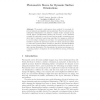Free Online Productivity Tools
i2Speak
i2Symbol
i2OCR
iTex2Img
iWeb2Print
iWeb2Shot
i2Type
iPdf2Split
iPdf2Merge
i2Bopomofo
i2Arabic
i2Style
i2Image
i2PDF
iLatex2Rtf
Sci2ools
ECCV
2010
Springer
2010
Springer
Photometric Stereo for Dynamic Surface Orientations
Abstract. We present a photometric stereo method for non-rigid objects of unknown and spatially varying materials. The prior art uses timemultiplexed illumination but assumes constant surface normals across several frames, fundamentally limiting the accuracy of the estimated normals. We explicitly account for time-varying surface orientations, and show that for unknown Lambertian materials, five images are sufficient to recover surface orientation in one frame. Our optimized system implementation exploits the physical properties of typical cameras and LEDs to reduce the required number of images to just three, and also facilitates frame-to-frame image alignment using standard optical flow methods, despite varying illumination. We demonstrate the system’s performance by computing surface orientations for several different moving, deforming objects.
Computer Vision | Constant Surface Normals | ECCV 2010 | Surface Orientations | Time-varying Surface Orientations |
| Added | 29 Sep 2010 |
| Updated | 29 Sep 2010 |
| Type | Conference |
| Year | 2010 |
| Where | ECCV |
Comments (0)

